Analyzing Workplace Transformation and Employee Turnover at Morrison
VerifiedAdded on 2023/06/18
|107
|19323
|416
Report
AI Summary
This research report investigates the relationship between workplace transformation and employee turnover, focusing on a case study of Morrison, a UK retailer. The report begins with an introduction outlining the research's context, significance, aims, and objectives, including an analysis of the impact of the global pandemic on accelerating workplace transformation. It reviews relevant literature, exploring both the positive and negative impacts of workplace transformation on sales and employee satisfaction. The research methodology section details the chosen research methods, type, philosophy, approach, time horizon, and ethical considerations. Data collection and analysis are presented, with findings discussed and summarized. The report concludes with a reflection on the effectiveness of the research methods, alternative approaches, and learning outcomes related to workplace transformation, along with recommendations for future research. The appendices include research proposals, ethics approval forms, questionnaires, and completed questionnaire responses.
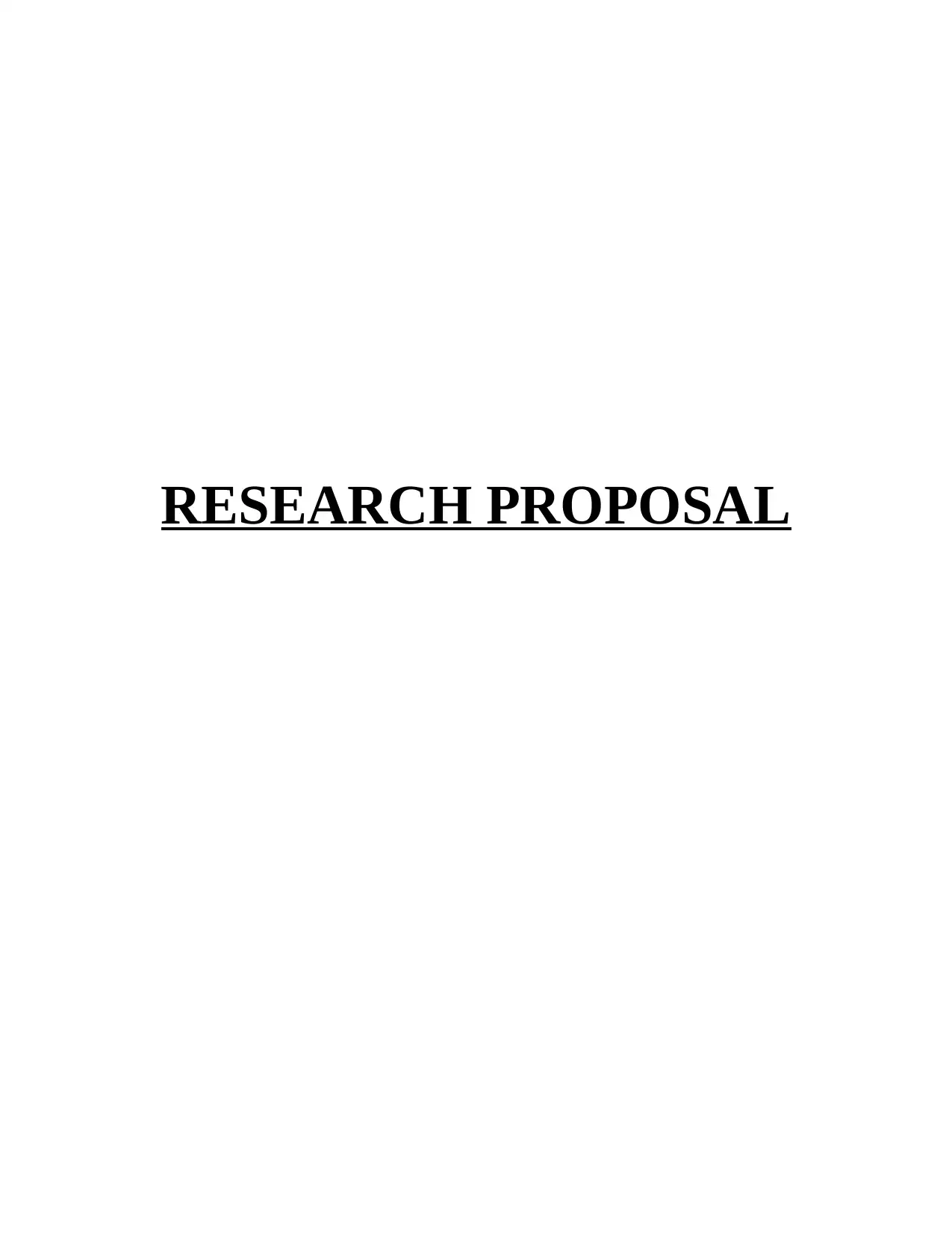
RESEARCH PROPOSAL
Paraphrase This Document
Need a fresh take? Get an instant paraphrase of this document with our AI Paraphraser
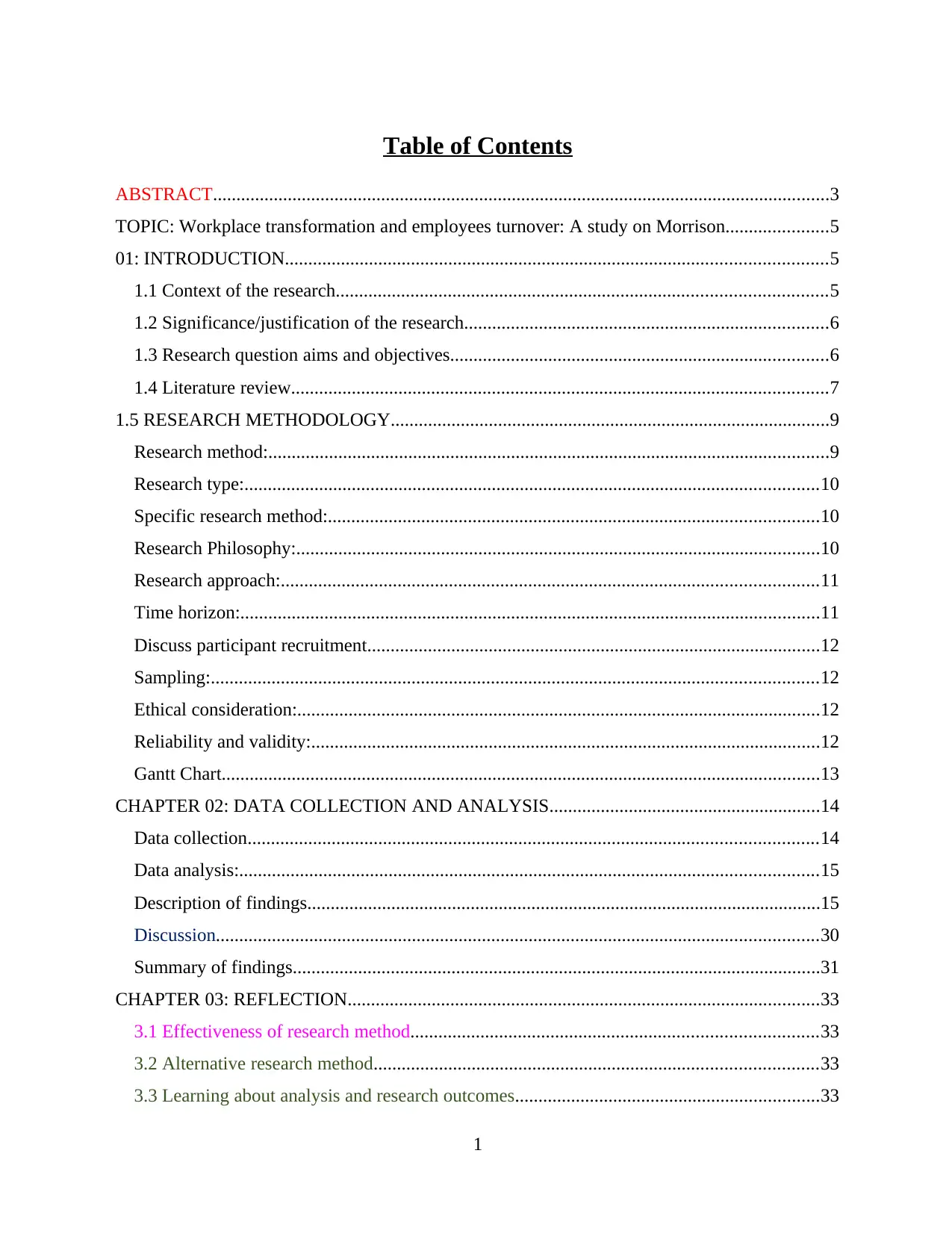
Table of Contents
ABSTRACT....................................................................................................................................3
TOPIC: Workplace transformation and employees turnover: A study on Morrison......................5
01: INTRODUCTION....................................................................................................................5
1.1 Context of the research.........................................................................................................5
1.2 Significance/justification of the research..............................................................................6
1.3 Research question aims and objectives.................................................................................6
1.4 Literature review...................................................................................................................7
1.5 RESEARCH METHODOLOGY..............................................................................................9
Research method:........................................................................................................................9
Research type:...........................................................................................................................10
Specific research method:.........................................................................................................10
Research Philosophy:................................................................................................................10
Research approach:...................................................................................................................11
Time horizon:............................................................................................................................11
Discuss participant recruitment.................................................................................................12
Sampling:..................................................................................................................................12
Ethical consideration:................................................................................................................12
Reliability and validity:.............................................................................................................12
Gantt Chart................................................................................................................................13
CHAPTER 02: DATA COLLECTION AND ANALYSIS..........................................................14
Data collection..........................................................................................................................14
Data analysis:............................................................................................................................15
Description of findings..............................................................................................................15
Discussion.................................................................................................................................30
Summary of findings.................................................................................................................31
CHAPTER 03: REFLECTION.....................................................................................................33
3.1 Effectiveness of research method.......................................................................................33
3.2 Alternative research method...............................................................................................33
3.3 Learning about analysis and research outcomes.................................................................33
1
ABSTRACT....................................................................................................................................3
TOPIC: Workplace transformation and employees turnover: A study on Morrison......................5
01: INTRODUCTION....................................................................................................................5
1.1 Context of the research.........................................................................................................5
1.2 Significance/justification of the research..............................................................................6
1.3 Research question aims and objectives.................................................................................6
1.4 Literature review...................................................................................................................7
1.5 RESEARCH METHODOLOGY..............................................................................................9
Research method:........................................................................................................................9
Research type:...........................................................................................................................10
Specific research method:.........................................................................................................10
Research Philosophy:................................................................................................................10
Research approach:...................................................................................................................11
Time horizon:............................................................................................................................11
Discuss participant recruitment.................................................................................................12
Sampling:..................................................................................................................................12
Ethical consideration:................................................................................................................12
Reliability and validity:.............................................................................................................12
Gantt Chart................................................................................................................................13
CHAPTER 02: DATA COLLECTION AND ANALYSIS..........................................................14
Data collection..........................................................................................................................14
Data analysis:............................................................................................................................15
Description of findings..............................................................................................................15
Discussion.................................................................................................................................30
Summary of findings.................................................................................................................31
CHAPTER 03: REFLECTION.....................................................................................................33
3.1 Effectiveness of research method.......................................................................................33
3.2 Alternative research method...............................................................................................33
3.3 Learning about analysis and research outcomes.................................................................33
1
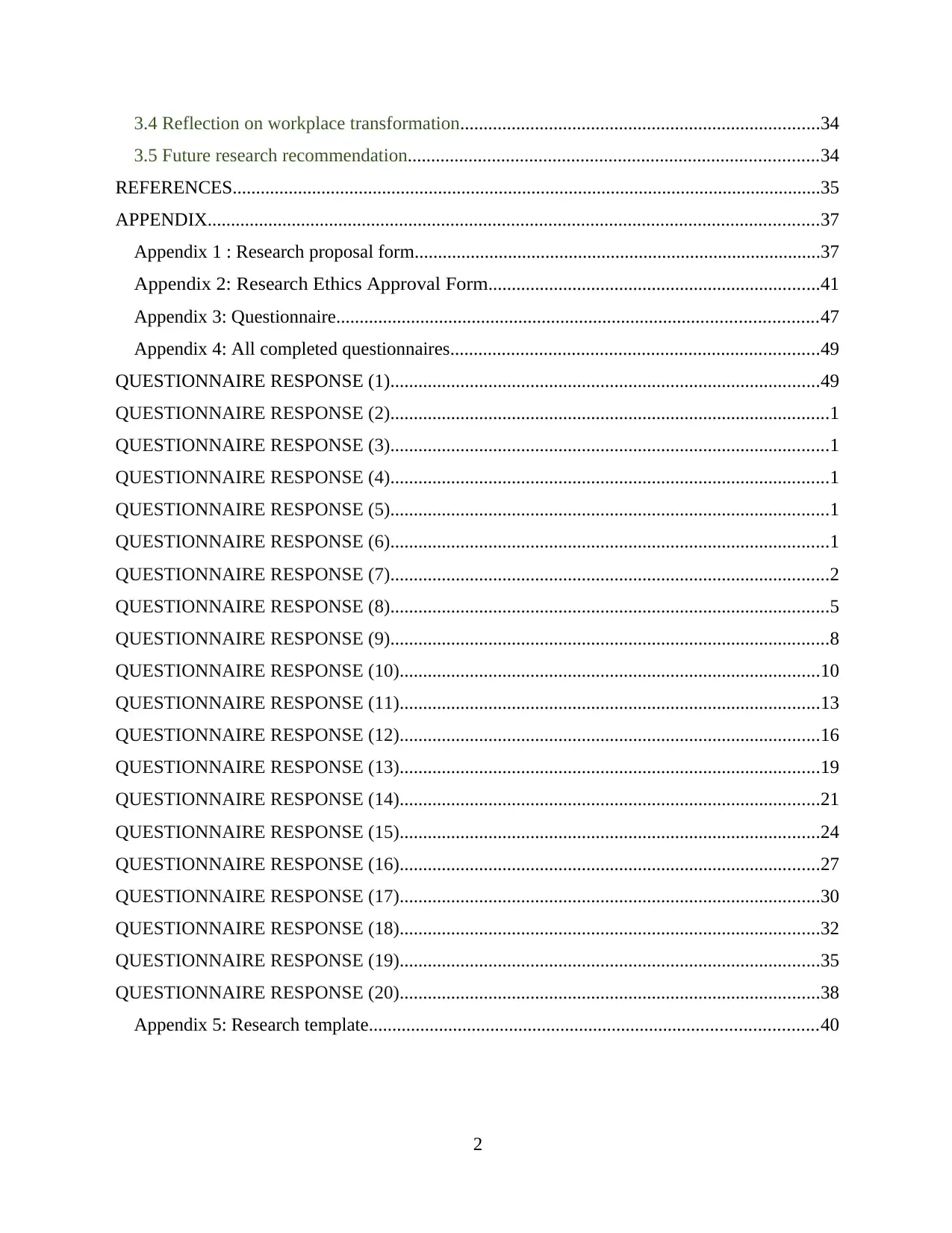
3.4 Reflection on workplace transformation.............................................................................34
3.5 Future research recommendation........................................................................................34
REFERENCES..............................................................................................................................35
APPENDIX...................................................................................................................................37
Appendix 1 : Research proposal form.......................................................................................37
Appendix 2: Research Ethics Approval Form.......................................................................41
Appendix 3: Questionnaire.......................................................................................................47
Appendix 4: All completed questionnaires...............................................................................49
QUESTIONNAIRE RESPONSE (1)............................................................................................49
QUESTIONNAIRE RESPONSE (2)..............................................................................................1
QUESTIONNAIRE RESPONSE (3)..............................................................................................1
QUESTIONNAIRE RESPONSE (4)..............................................................................................1
QUESTIONNAIRE RESPONSE (5)..............................................................................................1
QUESTIONNAIRE RESPONSE (6)..............................................................................................1
QUESTIONNAIRE RESPONSE (7)..............................................................................................2
QUESTIONNAIRE RESPONSE (8)..............................................................................................5
QUESTIONNAIRE RESPONSE (9)..............................................................................................8
QUESTIONNAIRE RESPONSE (10)..........................................................................................10
QUESTIONNAIRE RESPONSE (11)..........................................................................................13
QUESTIONNAIRE RESPONSE (12)..........................................................................................16
QUESTIONNAIRE RESPONSE (13)..........................................................................................19
QUESTIONNAIRE RESPONSE (14)..........................................................................................21
QUESTIONNAIRE RESPONSE (15)..........................................................................................24
QUESTIONNAIRE RESPONSE (16)..........................................................................................27
QUESTIONNAIRE RESPONSE (17)..........................................................................................30
QUESTIONNAIRE RESPONSE (18)..........................................................................................32
QUESTIONNAIRE RESPONSE (19)..........................................................................................35
QUESTIONNAIRE RESPONSE (20)..........................................................................................38
Appendix 5: Research template................................................................................................40
2
3.5 Future research recommendation........................................................................................34
REFERENCES..............................................................................................................................35
APPENDIX...................................................................................................................................37
Appendix 1 : Research proposal form.......................................................................................37
Appendix 2: Research Ethics Approval Form.......................................................................41
Appendix 3: Questionnaire.......................................................................................................47
Appendix 4: All completed questionnaires...............................................................................49
QUESTIONNAIRE RESPONSE (1)............................................................................................49
QUESTIONNAIRE RESPONSE (2)..............................................................................................1
QUESTIONNAIRE RESPONSE (3)..............................................................................................1
QUESTIONNAIRE RESPONSE (4)..............................................................................................1
QUESTIONNAIRE RESPONSE (5)..............................................................................................1
QUESTIONNAIRE RESPONSE (6)..............................................................................................1
QUESTIONNAIRE RESPONSE (7)..............................................................................................2
QUESTIONNAIRE RESPONSE (8)..............................................................................................5
QUESTIONNAIRE RESPONSE (9)..............................................................................................8
QUESTIONNAIRE RESPONSE (10)..........................................................................................10
QUESTIONNAIRE RESPONSE (11)..........................................................................................13
QUESTIONNAIRE RESPONSE (12)..........................................................................................16
QUESTIONNAIRE RESPONSE (13)..........................................................................................19
QUESTIONNAIRE RESPONSE (14)..........................................................................................21
QUESTIONNAIRE RESPONSE (15)..........................................................................................24
QUESTIONNAIRE RESPONSE (16)..........................................................................................27
QUESTIONNAIRE RESPONSE (17)..........................................................................................30
QUESTIONNAIRE RESPONSE (18)..........................................................................................32
QUESTIONNAIRE RESPONSE (19)..........................................................................................35
QUESTIONNAIRE RESPONSE (20)..........................................................................................38
Appendix 5: Research template................................................................................................40
2
⊘ This is a preview!⊘
Do you want full access?
Subscribe today to unlock all pages.

Trusted by 1+ million students worldwide
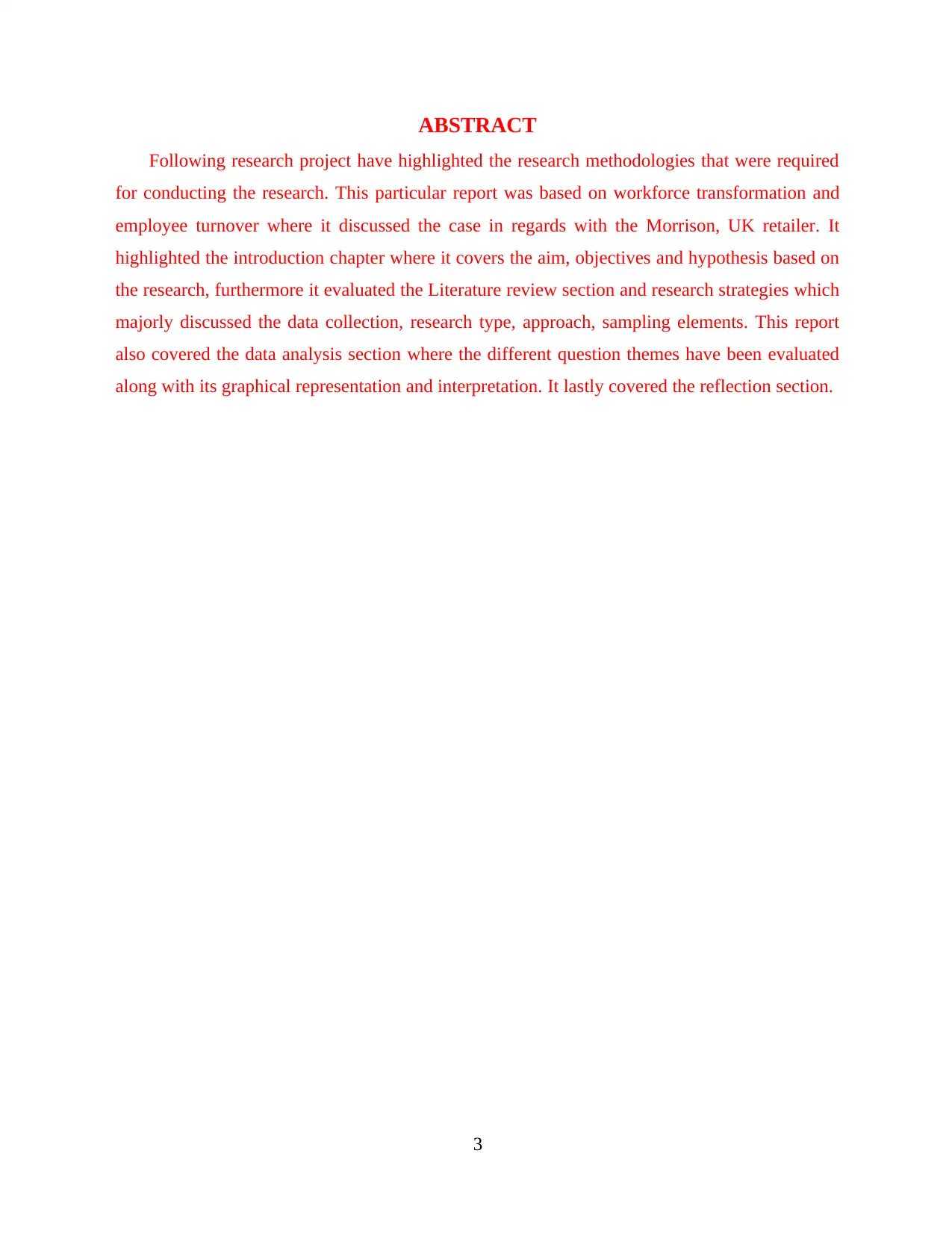
ABSTRACT
Following research project have highlighted the research methodologies that were required
for conducting the research. This particular report was based on workforce transformation and
employee turnover where it discussed the case in regards with the Morrison, UK retailer. It
highlighted the introduction chapter where it covers the aim, objectives and hypothesis based on
the research, furthermore it evaluated the Literature review section and research strategies which
majorly discussed the data collection, research type, approach, sampling elements. This report
also covered the data analysis section where the different question themes have been evaluated
along with its graphical representation and interpretation. It lastly covered the reflection section.
3
Following research project have highlighted the research methodologies that were required
for conducting the research. This particular report was based on workforce transformation and
employee turnover where it discussed the case in regards with the Morrison, UK retailer. It
highlighted the introduction chapter where it covers the aim, objectives and hypothesis based on
the research, furthermore it evaluated the Literature review section and research strategies which
majorly discussed the data collection, research type, approach, sampling elements. This report
also covered the data analysis section where the different question themes have been evaluated
along with its graphical representation and interpretation. It lastly covered the reflection section.
3
Paraphrase This Document
Need a fresh take? Get an instant paraphrase of this document with our AI Paraphraser
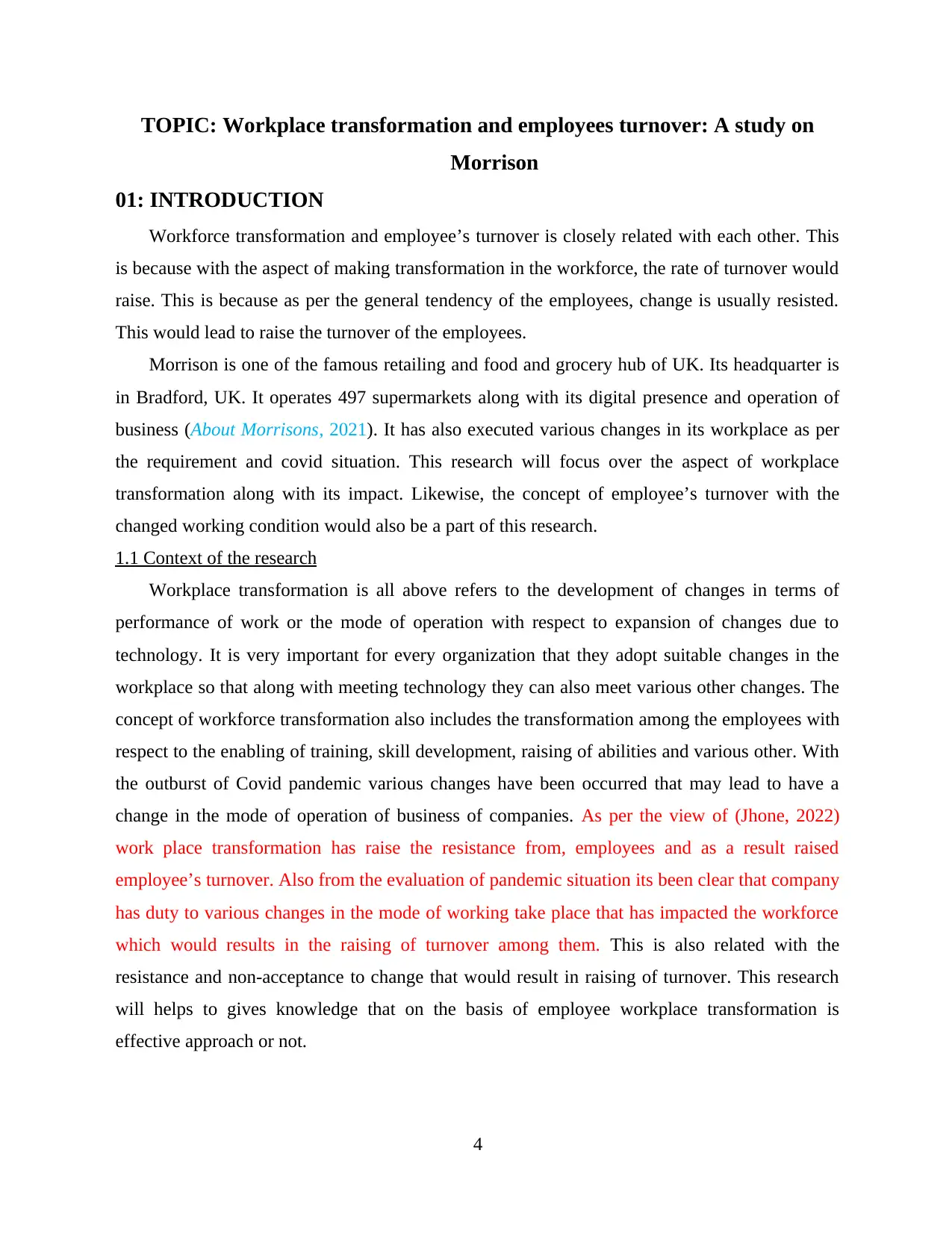
TOPIC: Workplace transformation and employees turnover: A study on
Morrison
01: INTRODUCTION
Workforce transformation and employee’s turnover is closely related with each other. This
is because with the aspect of making transformation in the workforce, the rate of turnover would
raise. This is because as per the general tendency of the employees, change is usually resisted.
This would lead to raise the turnover of the employees.
Morrison is one of the famous retailing and food and grocery hub of UK. Its headquarter is
in Bradford, UK. It operates 497 supermarkets along with its digital presence and operation of
business (About Morrisons, 2021). It has also executed various changes in its workplace as per
the requirement and covid situation. This research will focus over the aspect of workplace
transformation along with its impact. Likewise, the concept of employee’s turnover with the
changed working condition would also be a part of this research.
1.1 Context of the research
Workplace transformation is all above refers to the development of changes in terms of
performance of work or the mode of operation with respect to expansion of changes due to
technology. It is very important for every organization that they adopt suitable changes in the
workplace so that along with meeting technology they can also meet various other changes. The
concept of workforce transformation also includes the transformation among the employees with
respect to the enabling of training, skill development, raising of abilities and various other. With
the outburst of Covid pandemic various changes have been occurred that may lead to have a
change in the mode of operation of business of companies. As per the view of (Jhone, 2022)
work place transformation has raise the resistance from, employees and as a result raised
employee’s turnover. Also from the evaluation of pandemic situation its been clear that company
has duty to various changes in the mode of working take place that has impacted the workforce
which would results in the raising of turnover among them. This is also related with the
resistance and non-acceptance to change that would result in raising of turnover. This research
will helps to gives knowledge that on the basis of employee workplace transformation is
effective approach or not.
4
Morrison
01: INTRODUCTION
Workforce transformation and employee’s turnover is closely related with each other. This
is because with the aspect of making transformation in the workforce, the rate of turnover would
raise. This is because as per the general tendency of the employees, change is usually resisted.
This would lead to raise the turnover of the employees.
Morrison is one of the famous retailing and food and grocery hub of UK. Its headquarter is
in Bradford, UK. It operates 497 supermarkets along with its digital presence and operation of
business (About Morrisons, 2021). It has also executed various changes in its workplace as per
the requirement and covid situation. This research will focus over the aspect of workplace
transformation along with its impact. Likewise, the concept of employee’s turnover with the
changed working condition would also be a part of this research.
1.1 Context of the research
Workplace transformation is all above refers to the development of changes in terms of
performance of work or the mode of operation with respect to expansion of changes due to
technology. It is very important for every organization that they adopt suitable changes in the
workplace so that along with meeting technology they can also meet various other changes. The
concept of workforce transformation also includes the transformation among the employees with
respect to the enabling of training, skill development, raising of abilities and various other. With
the outburst of Covid pandemic various changes have been occurred that may lead to have a
change in the mode of operation of business of companies. As per the view of (Jhone, 2022)
work place transformation has raise the resistance from, employees and as a result raised
employee’s turnover. Also from the evaluation of pandemic situation its been clear that company
has duty to various changes in the mode of working take place that has impacted the workforce
which would results in the raising of turnover among them. This is also related with the
resistance and non-acceptance to change that would result in raising of turnover. This research
will helps to gives knowledge that on the basis of employee workplace transformation is
effective approach or not.
4
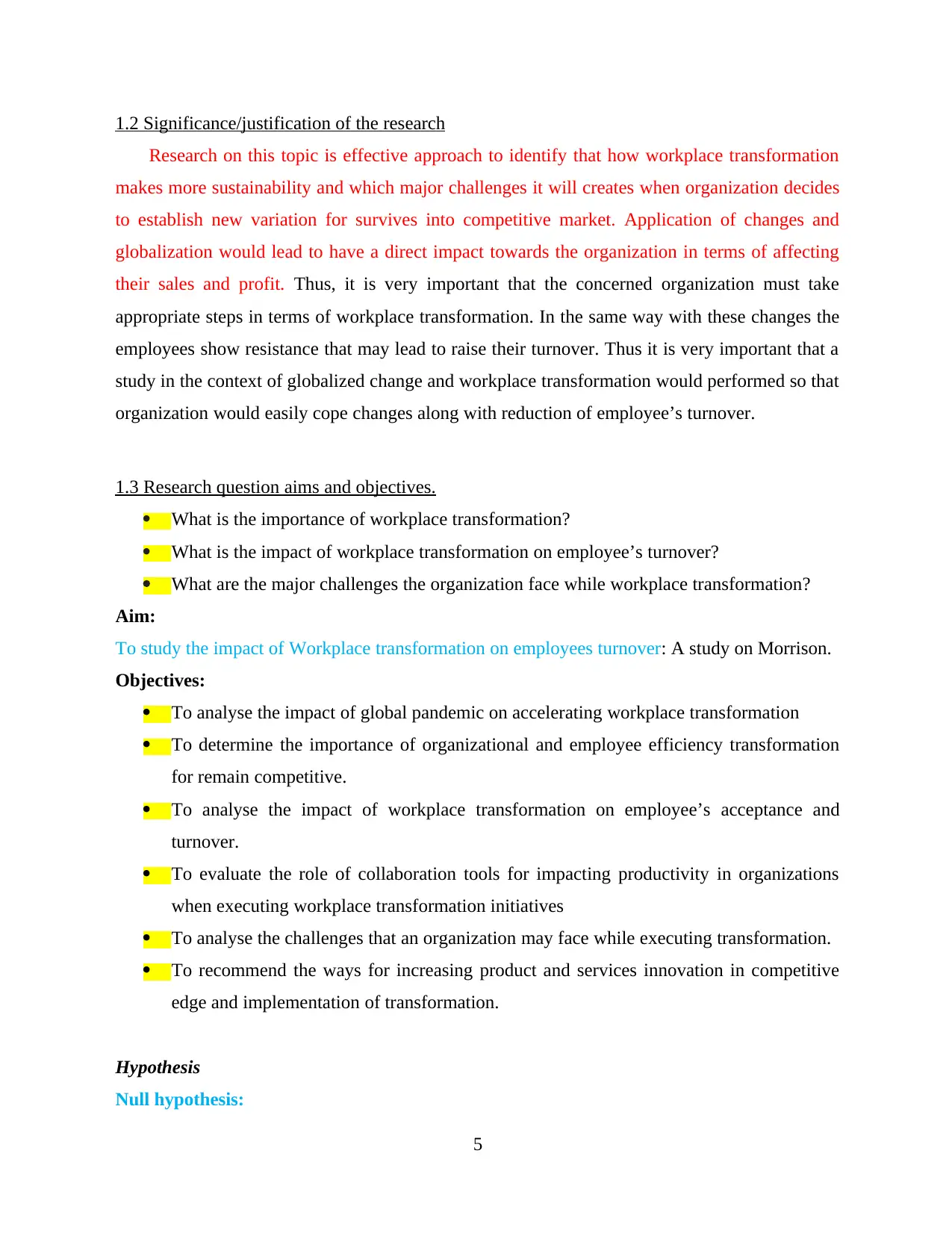
1.2 Significance/justification of the research
Research on this topic is effective approach to identify that how workplace transformation
makes more sustainability and which major challenges it will creates when organization decides
to establish new variation for survives into competitive market. Application of changes and
globalization would lead to have a direct impact towards the organization in terms of affecting
their sales and profit. Thus, it is very important that the concerned organization must take
appropriate steps in terms of workplace transformation. In the same way with these changes the
employees show resistance that may lead to raise their turnover. Thus it is very important that a
study in the context of globalized change and workplace transformation would performed so that
organization would easily cope changes along with reduction of employee’s turnover.
1.3 Research question aims and objectives.
What is the importance of workplace transformation?
What is the impact of workplace transformation on employee’s turnover?
What are the major challenges the organization face while workplace transformation?
Aim:
To study the impact of Workplace transformation on employees turnover: A study on Morrison.
Objectives:
To analyse the impact of global pandemic on accelerating workplace transformation
To determine the importance of organizational and employee efficiency transformation
for remain competitive.
To analyse the impact of workplace transformation on employee’s acceptance and
turnover.
To evaluate the role of collaboration tools for impacting productivity in organizations
when executing workplace transformation initiatives
To analyse the challenges that an organization may face while executing transformation.
To recommend the ways for increasing product and services innovation in competitive
edge and implementation of transformation.
Hypothesis
Null hypothesis:
5
Research on this topic is effective approach to identify that how workplace transformation
makes more sustainability and which major challenges it will creates when organization decides
to establish new variation for survives into competitive market. Application of changes and
globalization would lead to have a direct impact towards the organization in terms of affecting
their sales and profit. Thus, it is very important that the concerned organization must take
appropriate steps in terms of workplace transformation. In the same way with these changes the
employees show resistance that may lead to raise their turnover. Thus it is very important that a
study in the context of globalized change and workplace transformation would performed so that
organization would easily cope changes along with reduction of employee’s turnover.
1.3 Research question aims and objectives.
What is the importance of workplace transformation?
What is the impact of workplace transformation on employee’s turnover?
What are the major challenges the organization face while workplace transformation?
Aim:
To study the impact of Workplace transformation on employees turnover: A study on Morrison.
Objectives:
To analyse the impact of global pandemic on accelerating workplace transformation
To determine the importance of organizational and employee efficiency transformation
for remain competitive.
To analyse the impact of workplace transformation on employee’s acceptance and
turnover.
To evaluate the role of collaboration tools for impacting productivity in organizations
when executing workplace transformation initiatives
To analyse the challenges that an organization may face while executing transformation.
To recommend the ways for increasing product and services innovation in competitive
edge and implementation of transformation.
Hypothesis
Null hypothesis:
5
⊘ This is a preview!⊘
Do you want full access?
Subscribe today to unlock all pages.

Trusted by 1+ million students worldwide
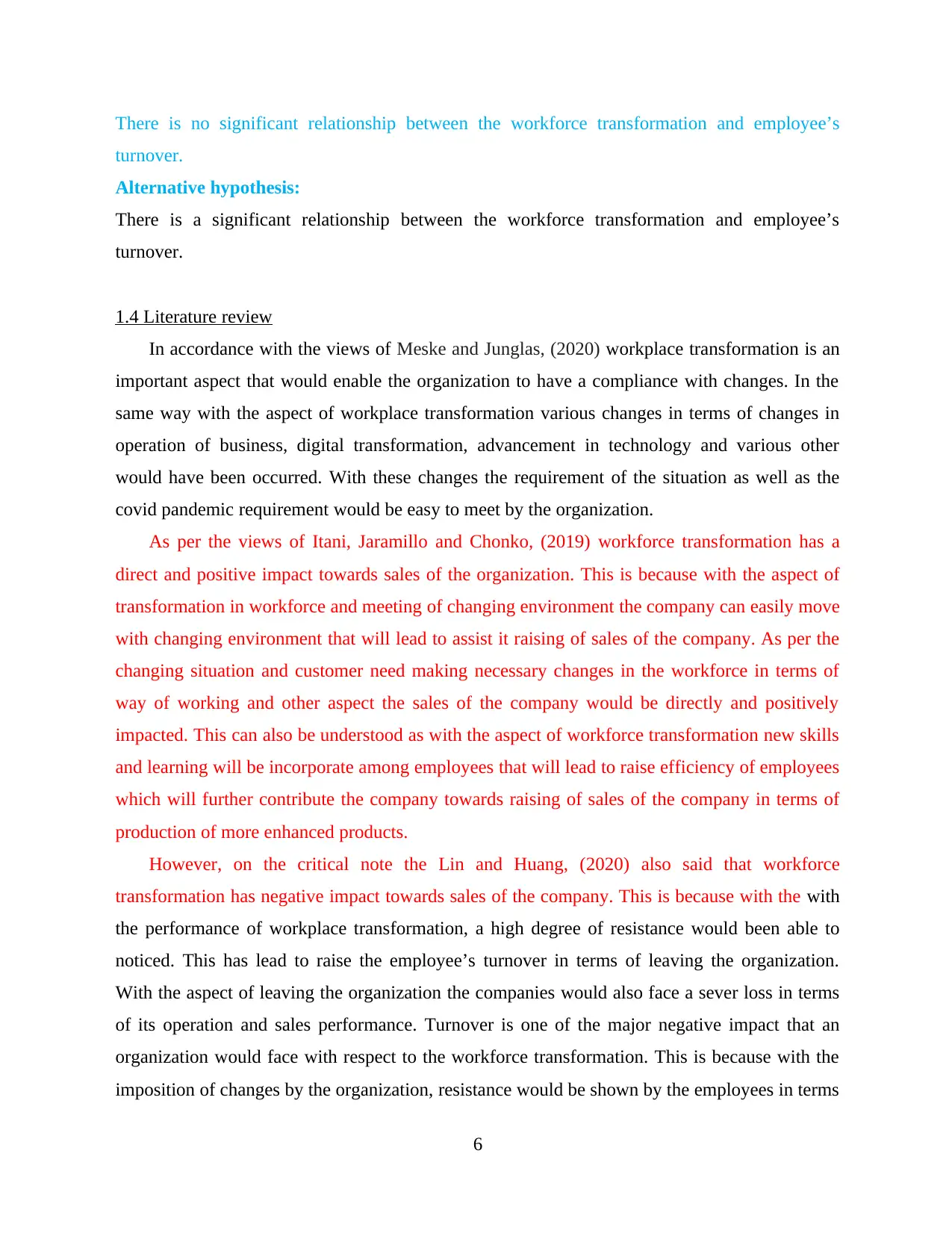
There is no significant relationship between the workforce transformation and employee’s
turnover.
Alternative hypothesis:
There is a significant relationship between the workforce transformation and employee’s
turnover.
1.4 Literature review
In accordance with the views of Meske and Junglas, (2020) workplace transformation is an
important aspect that would enable the organization to have a compliance with changes. In the
same way with the aspect of workplace transformation various changes in terms of changes in
operation of business, digital transformation, advancement in technology and various other
would have been occurred. With these changes the requirement of the situation as well as the
covid pandemic requirement would be easy to meet by the organization.
As per the views of Itani, Jaramillo and Chonko, (2019) workforce transformation has a
direct and positive impact towards sales of the organization. This is because with the aspect of
transformation in workforce and meeting of changing environment the company can easily move
with changing environment that will lead to assist it raising of sales of the company. As per the
changing situation and customer need making necessary changes in the workforce in terms of
way of working and other aspect the sales of the company would be directly and positively
impacted. This can also be understood as with the aspect of workforce transformation new skills
and learning will be incorporate among employees that will lead to raise efficiency of employees
which will further contribute the company towards raising of sales of the company in terms of
production of more enhanced products.
However, on the critical note the Lin and Huang, (2020) also said that workforce
transformation has negative impact towards sales of the company. This is because with the with
the performance of workplace transformation, a high degree of resistance would been able to
noticed. This has lead to raise the employee’s turnover in terms of leaving the organization.
With the aspect of leaving the organization the companies would also face a sever loss in terms
of its operation and sales performance. Turnover is one of the major negative impact that an
organization would face with respect to the workforce transformation. This is because with the
imposition of changes by the organization, resistance would be shown by the employees in terms
6
turnover.
Alternative hypothesis:
There is a significant relationship between the workforce transformation and employee’s
turnover.
1.4 Literature review
In accordance with the views of Meske and Junglas, (2020) workplace transformation is an
important aspect that would enable the organization to have a compliance with changes. In the
same way with the aspect of workplace transformation various changes in terms of changes in
operation of business, digital transformation, advancement in technology and various other
would have been occurred. With these changes the requirement of the situation as well as the
covid pandemic requirement would be easy to meet by the organization.
As per the views of Itani, Jaramillo and Chonko, (2019) workforce transformation has a
direct and positive impact towards sales of the organization. This is because with the aspect of
transformation in workforce and meeting of changing environment the company can easily move
with changing environment that will lead to assist it raising of sales of the company. As per the
changing situation and customer need making necessary changes in the workforce in terms of
way of working and other aspect the sales of the company would be directly and positively
impacted. This can also be understood as with the aspect of workforce transformation new skills
and learning will be incorporate among employees that will lead to raise efficiency of employees
which will further contribute the company towards raising of sales of the company in terms of
production of more enhanced products.
However, on the critical note the Lin and Huang, (2020) also said that workforce
transformation has negative impact towards sales of the company. This is because with the with
the performance of workplace transformation, a high degree of resistance would been able to
noticed. This has lead to raise the employee’s turnover in terms of leaving the organization.
With the aspect of leaving the organization the companies would also face a sever loss in terms
of its operation and sales performance. Turnover is one of the major negative impact that an
organization would face with respect to the workforce transformation. This is because with the
imposition of changes by the organization, resistance would be shown by the employees in terms
6
Paraphrase This Document
Need a fresh take? Get an instant paraphrase of this document with our AI Paraphraser
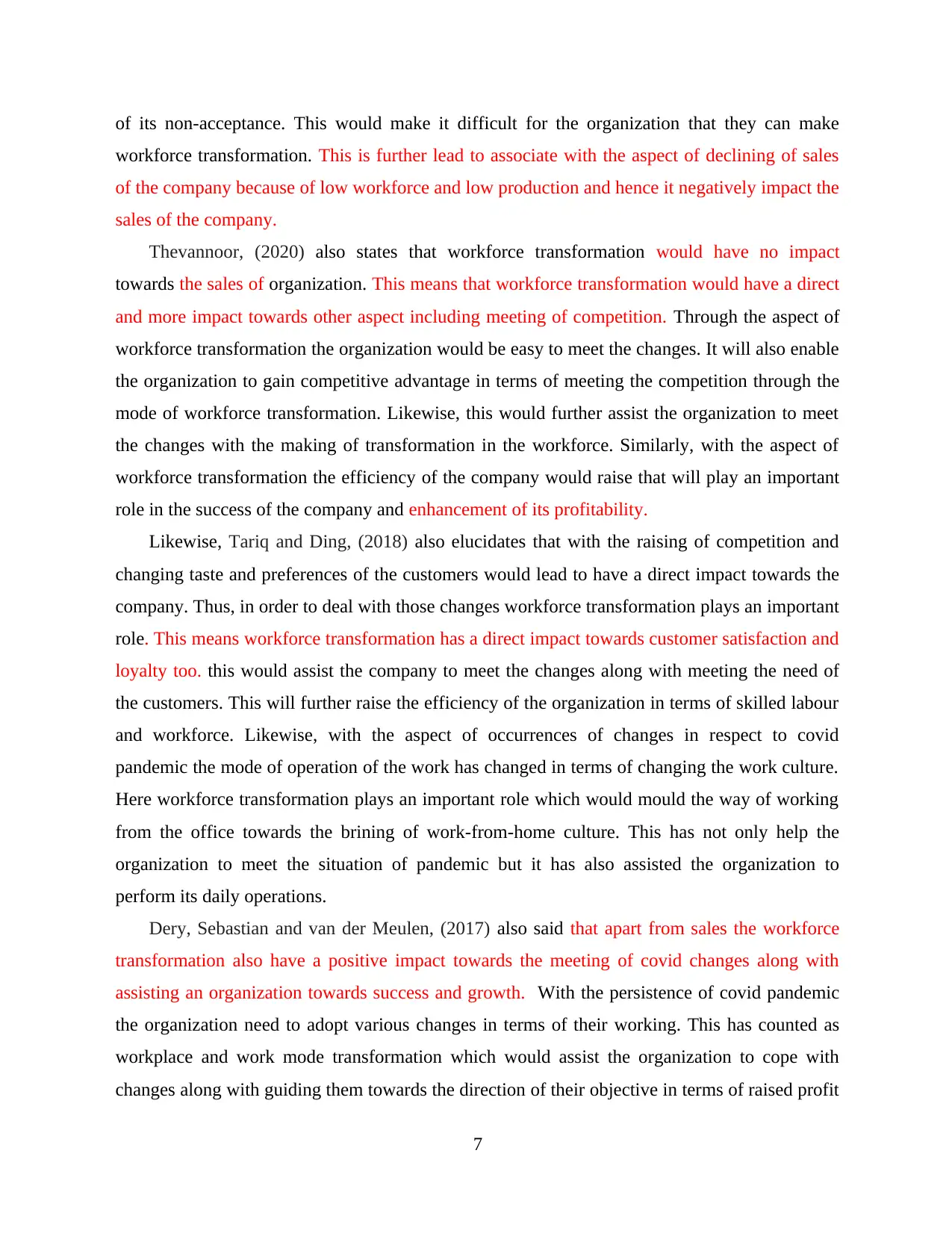
of its non-acceptance. This would make it difficult for the organization that they can make
workforce transformation. This is further lead to associate with the aspect of declining of sales
of the company because of low workforce and low production and hence it negatively impact the
sales of the company.
Thevannoor, (2020) also states that workforce transformation would have no impact
towards the sales of organization. This means that workforce transformation would have a direct
and more impact towards other aspect including meeting of competition. Through the aspect of
workforce transformation the organization would be easy to meet the changes. It will also enable
the organization to gain competitive advantage in terms of meeting the competition through the
mode of workforce transformation. Likewise, this would further assist the organization to meet
the changes with the making of transformation in the workforce. Similarly, with the aspect of
workforce transformation the efficiency of the company would raise that will play an important
role in the success of the company and enhancement of its profitability.
Likewise, Tariq and Ding, (2018) also elucidates that with the raising of competition and
changing taste and preferences of the customers would lead to have a direct impact towards the
company. Thus, in order to deal with those changes workforce transformation plays an important
role. This means workforce transformation has a direct impact towards customer satisfaction and
loyalty too. this would assist the company to meet the changes along with meeting the need of
the customers. This will further raise the efficiency of the organization in terms of skilled labour
and workforce. Likewise, with the aspect of occurrences of changes in respect to covid
pandemic the mode of operation of the work has changed in terms of changing the work culture.
Here workforce transformation plays an important role which would mould the way of working
from the office towards the brining of work-from-home culture. This has not only help the
organization to meet the situation of pandemic but it has also assisted the organization to
perform its daily operations.
Dery, Sebastian and van der Meulen, (2017) also said that apart from sales the workforce
transformation also have a positive impact towards the meeting of covid changes along with
assisting an organization towards success and growth. With the persistence of covid pandemic
the organization need to adopt various changes in terms of their working. This has counted as
workplace and work mode transformation which would assist the organization to cope with
changes along with guiding them towards the direction of their objective in terms of raised profit
7
workforce transformation. This is further lead to associate with the aspect of declining of sales
of the company because of low workforce and low production and hence it negatively impact the
sales of the company.
Thevannoor, (2020) also states that workforce transformation would have no impact
towards the sales of organization. This means that workforce transformation would have a direct
and more impact towards other aspect including meeting of competition. Through the aspect of
workforce transformation the organization would be easy to meet the changes. It will also enable
the organization to gain competitive advantage in terms of meeting the competition through the
mode of workforce transformation. Likewise, this would further assist the organization to meet
the changes with the making of transformation in the workforce. Similarly, with the aspect of
workforce transformation the efficiency of the company would raise that will play an important
role in the success of the company and enhancement of its profitability.
Likewise, Tariq and Ding, (2018) also elucidates that with the raising of competition and
changing taste and preferences of the customers would lead to have a direct impact towards the
company. Thus, in order to deal with those changes workforce transformation plays an important
role. This means workforce transformation has a direct impact towards customer satisfaction and
loyalty too. this would assist the company to meet the changes along with meeting the need of
the customers. This will further raise the efficiency of the organization in terms of skilled labour
and workforce. Likewise, with the aspect of occurrences of changes in respect to covid
pandemic the mode of operation of the work has changed in terms of changing the work culture.
Here workforce transformation plays an important role which would mould the way of working
from the office towards the brining of work-from-home culture. This has not only help the
organization to meet the situation of pandemic but it has also assisted the organization to
perform its daily operations.
Dery, Sebastian and van der Meulen, (2017) also said that apart from sales the workforce
transformation also have a positive impact towards the meeting of covid changes along with
assisting an organization towards success and growth. With the persistence of covid pandemic
the organization need to adopt various changes in terms of their working. This has counted as
workplace and work mode transformation which would assist the organization to cope with
changes along with guiding them towards the direction of their objective in terms of raised profit
7
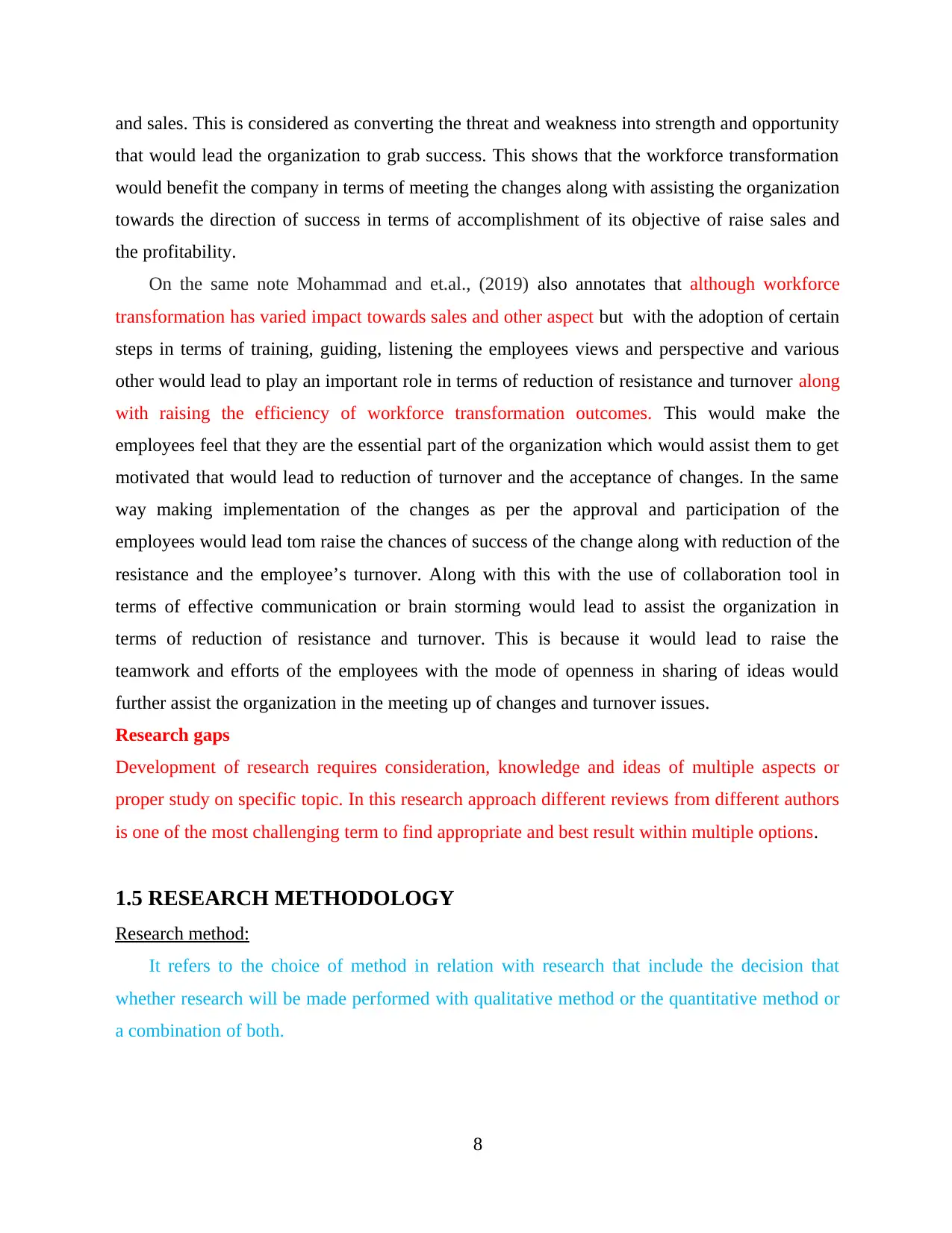
and sales. This is considered as converting the threat and weakness into strength and opportunity
that would lead the organization to grab success. This shows that the workforce transformation
would benefit the company in terms of meeting the changes along with assisting the organization
towards the direction of success in terms of accomplishment of its objective of raise sales and
the profitability.
On the same note Mohammad and et.al., (2019) also annotates that although workforce
transformation has varied impact towards sales and other aspect but with the adoption of certain
steps in terms of training, guiding, listening the employees views and perspective and various
other would lead to play an important role in terms of reduction of resistance and turnover along
with raising the efficiency of workforce transformation outcomes. This would make the
employees feel that they are the essential part of the organization which would assist them to get
motivated that would lead to reduction of turnover and the acceptance of changes. In the same
way making implementation of the changes as per the approval and participation of the
employees would lead tom raise the chances of success of the change along with reduction of the
resistance and the employee’s turnover. Along with this with the use of collaboration tool in
terms of effective communication or brain storming would lead to assist the organization in
terms of reduction of resistance and turnover. This is because it would lead to raise the
teamwork and efforts of the employees with the mode of openness in sharing of ideas would
further assist the organization in the meeting up of changes and turnover issues.
Research gaps
Development of research requires consideration, knowledge and ideas of multiple aspects or
proper study on specific topic. In this research approach different reviews from different authors
is one of the most challenging term to find appropriate and best result within multiple options.
1.5 RESEARCH METHODOLOGY
Research method:
It refers to the choice of method in relation with research that include the decision that
whether research will be made performed with qualitative method or the quantitative method or
a combination of both.
8
that would lead the organization to grab success. This shows that the workforce transformation
would benefit the company in terms of meeting the changes along with assisting the organization
towards the direction of success in terms of accomplishment of its objective of raise sales and
the profitability.
On the same note Mohammad and et.al., (2019) also annotates that although workforce
transformation has varied impact towards sales and other aspect but with the adoption of certain
steps in terms of training, guiding, listening the employees views and perspective and various
other would lead to play an important role in terms of reduction of resistance and turnover along
with raising the efficiency of workforce transformation outcomes. This would make the
employees feel that they are the essential part of the organization which would assist them to get
motivated that would lead to reduction of turnover and the acceptance of changes. In the same
way making implementation of the changes as per the approval and participation of the
employees would lead tom raise the chances of success of the change along with reduction of the
resistance and the employee’s turnover. Along with this with the use of collaboration tool in
terms of effective communication or brain storming would lead to assist the organization in
terms of reduction of resistance and turnover. This is because it would lead to raise the
teamwork and efforts of the employees with the mode of openness in sharing of ideas would
further assist the organization in the meeting up of changes and turnover issues.
Research gaps
Development of research requires consideration, knowledge and ideas of multiple aspects or
proper study on specific topic. In this research approach different reviews from different authors
is one of the most challenging term to find appropriate and best result within multiple options.
1.5 RESEARCH METHODOLOGY
Research method:
It refers to the choice of method in relation with research that include the decision that
whether research will be made performed with qualitative method or the quantitative method or
a combination of both.
8
⊘ This is a preview!⊘
Do you want full access?
Subscribe today to unlock all pages.

Trusted by 1+ million students worldwide
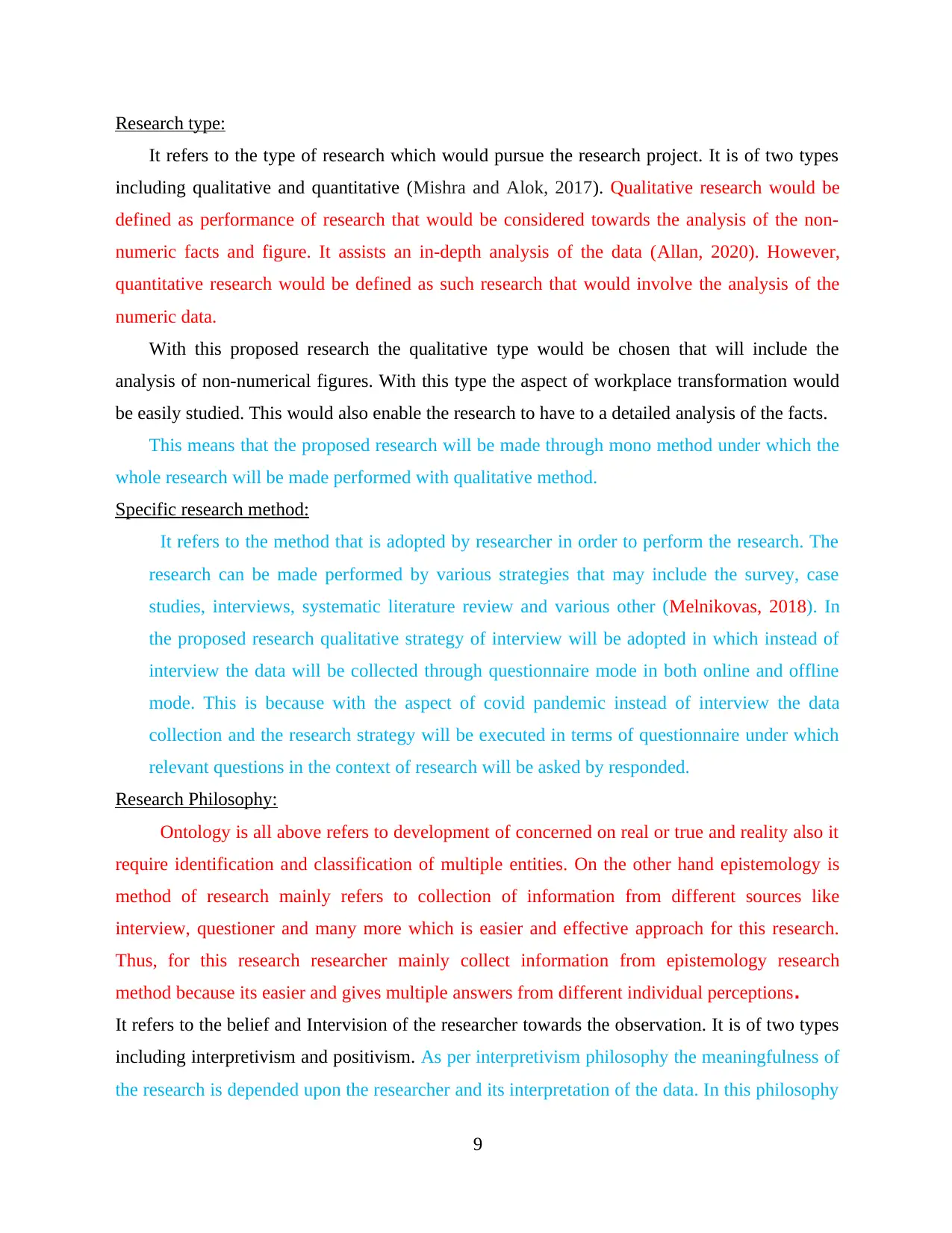
Research type:
It refers to the type of research which would pursue the research project. It is of two types
including qualitative and quantitative (Mishra and Alok, 2017). Qualitative research would be
defined as performance of research that would be considered towards the analysis of the non-
numeric facts and figure. It assists an in-depth analysis of the data (Allan, 2020). However,
quantitative research would be defined as such research that would involve the analysis of the
numeric data.
With this proposed research the qualitative type would be chosen that will include the
analysis of non-numerical figures. With this type the aspect of workplace transformation would
be easily studied. This would also enable the research to have to a detailed analysis of the facts.
This means that the proposed research will be made through mono method under which the
whole research will be made performed with qualitative method.
Specific research method:
It refers to the method that is adopted by researcher in order to perform the research. The
research can be made performed by various strategies that may include the survey, case
studies, interviews, systematic literature review and various other (Melnikovas, 2018). In
the proposed research qualitative strategy of interview will be adopted in which instead of
interview the data will be collected through questionnaire mode in both online and offline
mode. This is because with the aspect of covid pandemic instead of interview the data
collection and the research strategy will be executed in terms of questionnaire under which
relevant questions in the context of research will be asked by responded.
Research Philosophy:
Ontology is all above refers to development of concerned on real or true and reality also it
require identification and classification of multiple entities. On the other hand epistemology is
method of research mainly refers to collection of information from different sources like
interview, questioner and many more which is easier and effective approach for this research.
Thus, for this research researcher mainly collect information from epistemology research
method because its easier and gives multiple answers from different individual perceptions.
It refers to the belief and Intervision of the researcher towards the observation. It is of two types
including interpretivism and positivism. As per interpretivism philosophy the meaningfulness of
the research is depended upon the researcher and its interpretation of the data. In this philosophy
9
It refers to the type of research which would pursue the research project. It is of two types
including qualitative and quantitative (Mishra and Alok, 2017). Qualitative research would be
defined as performance of research that would be considered towards the analysis of the non-
numeric facts and figure. It assists an in-depth analysis of the data (Allan, 2020). However,
quantitative research would be defined as such research that would involve the analysis of the
numeric data.
With this proposed research the qualitative type would be chosen that will include the
analysis of non-numerical figures. With this type the aspect of workplace transformation would
be easily studied. This would also enable the research to have to a detailed analysis of the facts.
This means that the proposed research will be made through mono method under which the
whole research will be made performed with qualitative method.
Specific research method:
It refers to the method that is adopted by researcher in order to perform the research. The
research can be made performed by various strategies that may include the survey, case
studies, interviews, systematic literature review and various other (Melnikovas, 2018). In
the proposed research qualitative strategy of interview will be adopted in which instead of
interview the data will be collected through questionnaire mode in both online and offline
mode. This is because with the aspect of covid pandemic instead of interview the data
collection and the research strategy will be executed in terms of questionnaire under which
relevant questions in the context of research will be asked by responded.
Research Philosophy:
Ontology is all above refers to development of concerned on real or true and reality also it
require identification and classification of multiple entities. On the other hand epistemology is
method of research mainly refers to collection of information from different sources like
interview, questioner and many more which is easier and effective approach for this research.
Thus, for this research researcher mainly collect information from epistemology research
method because its easier and gives multiple answers from different individual perceptions.
It refers to the belief and Intervision of the researcher towards the observation. It is of two types
including interpretivism and positivism. As per interpretivism philosophy the meaningfulness of
the research is depended upon the researcher and its interpretation of the data. In this philosophy
9
Paraphrase This Document
Need a fresh take? Get an instant paraphrase of this document with our AI Paraphraser
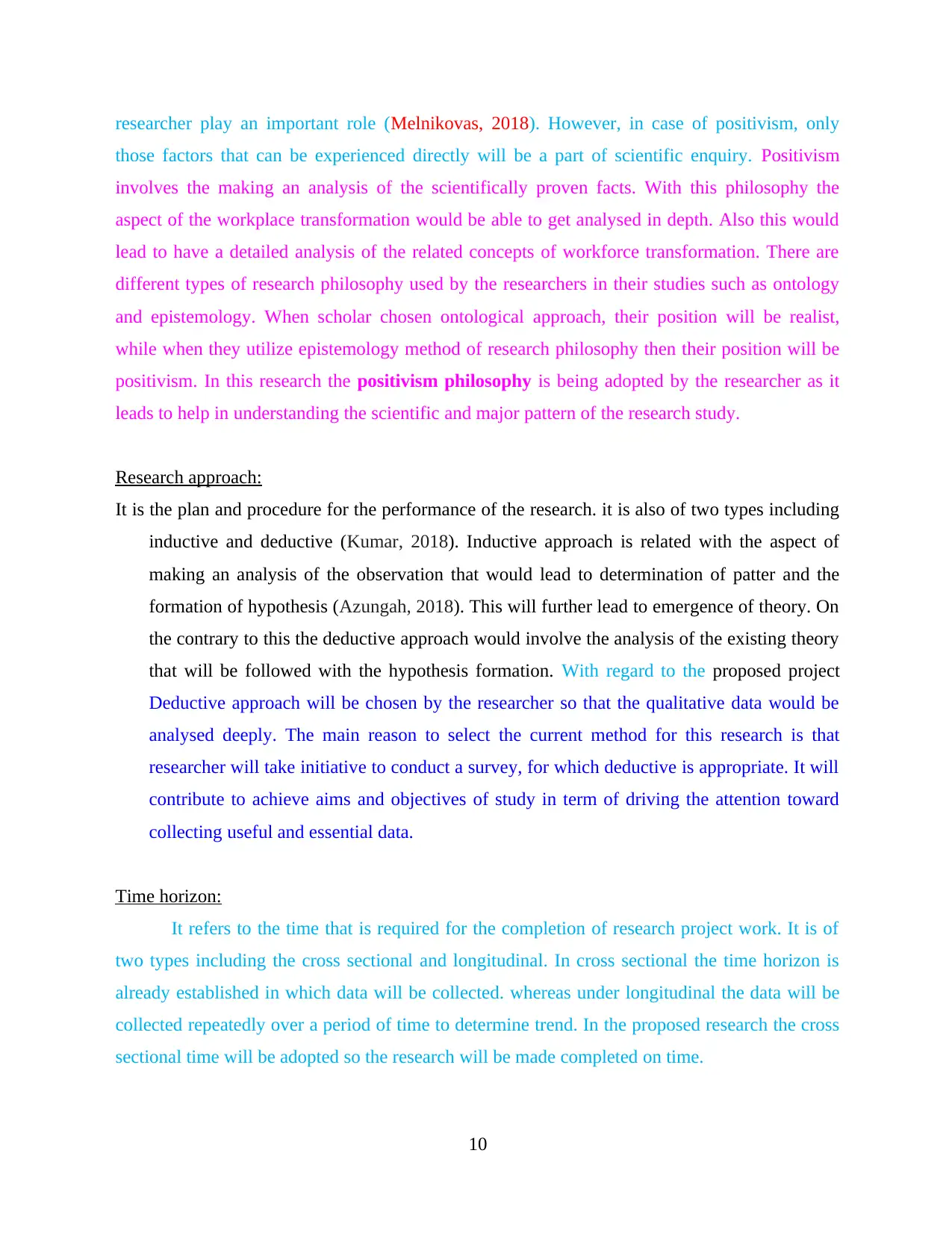
researcher play an important role (Melnikovas, 2018). However, in case of positivism, only
those factors that can be experienced directly will be a part of scientific enquiry. Positivism
involves the making an analysis of the scientifically proven facts. With this philosophy the
aspect of the workplace transformation would be able to get analysed in depth. Also this would
lead to have a detailed analysis of the related concepts of workforce transformation. There are
different types of research philosophy used by the researchers in their studies such as ontology
and epistemology. When scholar chosen ontological approach, their position will be realist,
while when they utilize epistemology method of research philosophy then their position will be
positivism. In this research the positivism philosophy is being adopted by the researcher as it
leads to help in understanding the scientific and major pattern of the research study.
Research approach:
It is the plan and procedure for the performance of the research. it is also of two types including
inductive and deductive (Kumar, 2018). Inductive approach is related with the aspect of
making an analysis of the observation that would lead to determination of patter and the
formation of hypothesis (Azungah, 2018). This will further lead to emergence of theory. On
the contrary to this the deductive approach would involve the analysis of the existing theory
that will be followed with the hypothesis formation. With regard to the proposed project
Deductive approach will be chosen by the researcher so that the qualitative data would be
analysed deeply. The main reason to select the current method for this research is that
researcher will take initiative to conduct a survey, for which deductive is appropriate. It will
contribute to achieve aims and objectives of study in term of driving the attention toward
collecting useful and essential data.
Time horizon:
It refers to the time that is required for the completion of research project work. It is of
two types including the cross sectional and longitudinal. In cross sectional the time horizon is
already established in which data will be collected. whereas under longitudinal the data will be
collected repeatedly over a period of time to determine trend. In the proposed research the cross
sectional time will be adopted so the research will be made completed on time.
10
those factors that can be experienced directly will be a part of scientific enquiry. Positivism
involves the making an analysis of the scientifically proven facts. With this philosophy the
aspect of the workplace transformation would be able to get analysed in depth. Also this would
lead to have a detailed analysis of the related concepts of workforce transformation. There are
different types of research philosophy used by the researchers in their studies such as ontology
and epistemology. When scholar chosen ontological approach, their position will be realist,
while when they utilize epistemology method of research philosophy then their position will be
positivism. In this research the positivism philosophy is being adopted by the researcher as it
leads to help in understanding the scientific and major pattern of the research study.
Research approach:
It is the plan and procedure for the performance of the research. it is also of two types including
inductive and deductive (Kumar, 2018). Inductive approach is related with the aspect of
making an analysis of the observation that would lead to determination of patter and the
formation of hypothesis (Azungah, 2018). This will further lead to emergence of theory. On
the contrary to this the deductive approach would involve the analysis of the existing theory
that will be followed with the hypothesis formation. With regard to the proposed project
Deductive approach will be chosen by the researcher so that the qualitative data would be
analysed deeply. The main reason to select the current method for this research is that
researcher will take initiative to conduct a survey, for which deductive is appropriate. It will
contribute to achieve aims and objectives of study in term of driving the attention toward
collecting useful and essential data.
Time horizon:
It refers to the time that is required for the completion of research project work. It is of
two types including the cross sectional and longitudinal. In cross sectional the time horizon is
already established in which data will be collected. whereas under longitudinal the data will be
collected repeatedly over a period of time to determine trend. In the proposed research the cross
sectional time will be adopted so the research will be made completed on time.
10
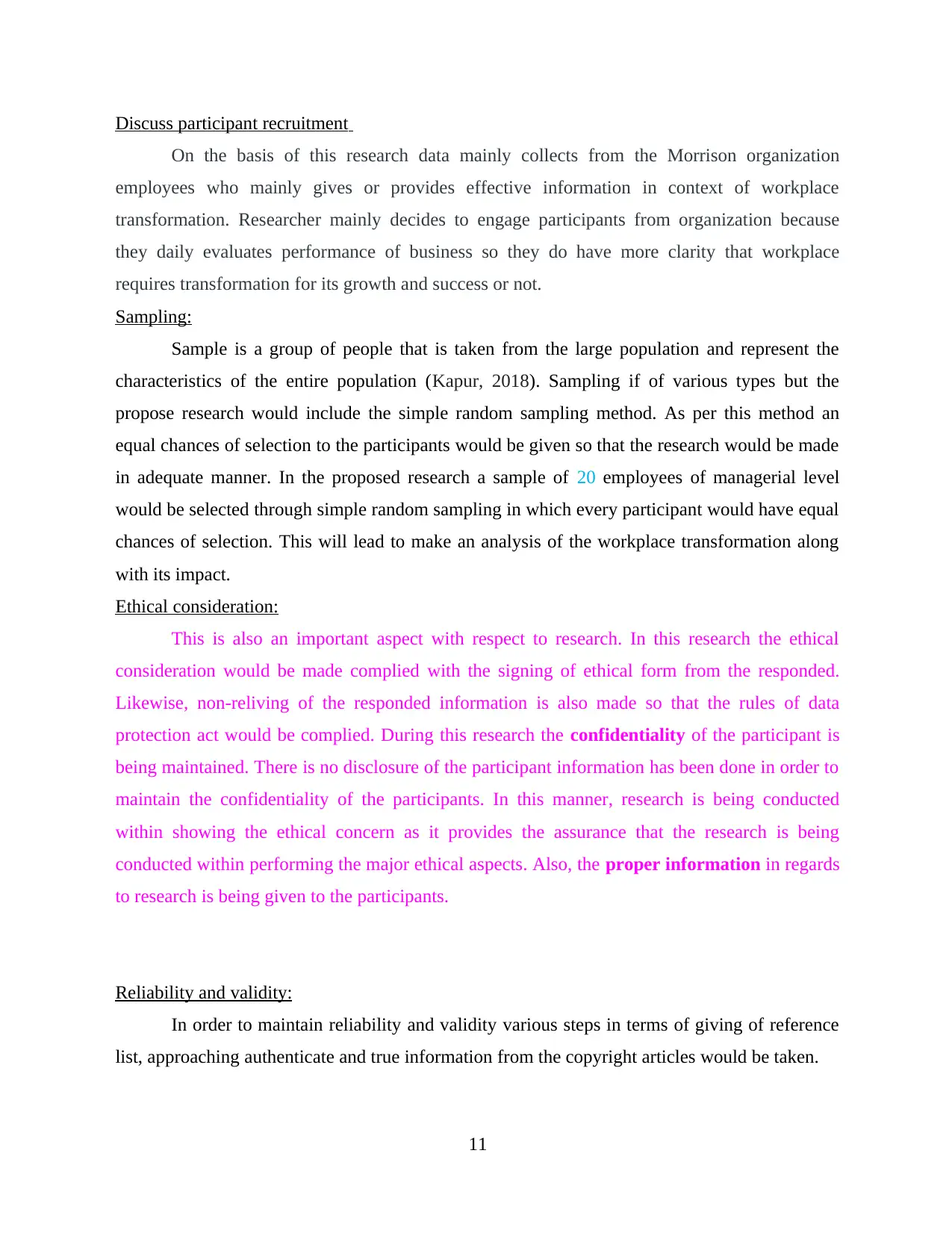
Discuss participant recruitment
On the basis of this research data mainly collects from the Morrison organization
employees who mainly gives or provides effective information in context of workplace
transformation. Researcher mainly decides to engage participants from organization because
they daily evaluates performance of business so they do have more clarity that workplace
requires transformation for its growth and success or not.
Sampling:
Sample is a group of people that is taken from the large population and represent the
characteristics of the entire population (Kapur, 2018). Sampling if of various types but the
propose research would include the simple random sampling method. As per this method an
equal chances of selection to the participants would be given so that the research would be made
in adequate manner. In the proposed research a sample of 20 employees of managerial level
would be selected through simple random sampling in which every participant would have equal
chances of selection. This will lead to make an analysis of the workplace transformation along
with its impact.
Ethical consideration:
This is also an important aspect with respect to research. In this research the ethical
consideration would be made complied with the signing of ethical form from the responded.
Likewise, non-reliving of the responded information is also made so that the rules of data
protection act would be complied. During this research the confidentiality of the participant is
being maintained. There is no disclosure of the participant information has been done in order to
maintain the confidentiality of the participants. In this manner, research is being conducted
within showing the ethical concern as it provides the assurance that the research is being
conducted within performing the major ethical aspects. Also, the proper information in regards
to research is being given to the participants.
Reliability and validity:
In order to maintain reliability and validity various steps in terms of giving of reference
list, approaching authenticate and true information from the copyright articles would be taken.
11
On the basis of this research data mainly collects from the Morrison organization
employees who mainly gives or provides effective information in context of workplace
transformation. Researcher mainly decides to engage participants from organization because
they daily evaluates performance of business so they do have more clarity that workplace
requires transformation for its growth and success or not.
Sampling:
Sample is a group of people that is taken from the large population and represent the
characteristics of the entire population (Kapur, 2018). Sampling if of various types but the
propose research would include the simple random sampling method. As per this method an
equal chances of selection to the participants would be given so that the research would be made
in adequate manner. In the proposed research a sample of 20 employees of managerial level
would be selected through simple random sampling in which every participant would have equal
chances of selection. This will lead to make an analysis of the workplace transformation along
with its impact.
Ethical consideration:
This is also an important aspect with respect to research. In this research the ethical
consideration would be made complied with the signing of ethical form from the responded.
Likewise, non-reliving of the responded information is also made so that the rules of data
protection act would be complied. During this research the confidentiality of the participant is
being maintained. There is no disclosure of the participant information has been done in order to
maintain the confidentiality of the participants. In this manner, research is being conducted
within showing the ethical concern as it provides the assurance that the research is being
conducted within performing the major ethical aspects. Also, the proper information in regards
to research is being given to the participants.
Reliability and validity:
In order to maintain reliability and validity various steps in terms of giving of reference
list, approaching authenticate and true information from the copyright articles would be taken.
11
⊘ This is a preview!⊘
Do you want full access?
Subscribe today to unlock all pages.

Trusted by 1+ million students worldwide
1 out of 107
Related Documents
Your All-in-One AI-Powered Toolkit for Academic Success.
+13062052269
info@desklib.com
Available 24*7 on WhatsApp / Email
![[object Object]](/_next/static/media/star-bottom.7253800d.svg)
Unlock your academic potential
Copyright © 2020–2025 A2Z Services. All Rights Reserved. Developed and managed by ZUCOL.





